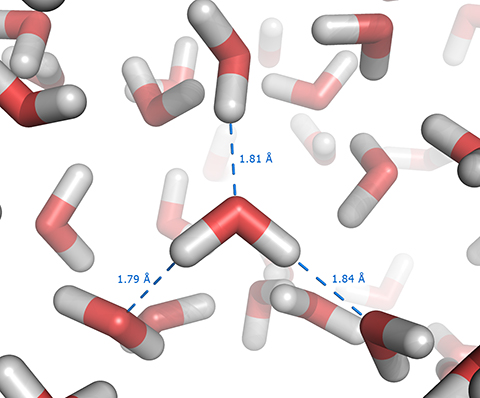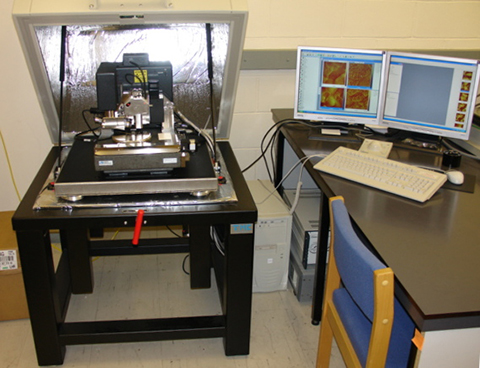
The subtle strength of hydrogen bonds
Water is weird. Compared to other common liquids of similar molecular weight, water has high surface tension, high density, unusually high boiling and melting points, and significant heat capacity — all thanks to hydrogen bonding.
Hydrogen bonding is the force of attraction between the partially positive hydrogen atom of one water molecule and the partially negative oxygen atom of another. This force may be weak compared to covalent bonds, but it wields powerful effects in biological systems and can make the nanoscale investigation of such systems quite challenging.

Challenges of imaging in water
My personal encounter with the peculiarities of hydrogen bonding occurred during graduate research 15 years ago where I focused on studying collagen — a key structural protein — using atomic force microscopy or AFM. AFM is an advanced imaging technique that uses a sharp, nanometer-scale tip attached to a flexible cantilever with a laser beam pointed on top. Much like an old-fashioned gramophone needle traces the grooves of a record to produce sound, the tip scans the surface and the degree of deflection of the tip is translated into detailed topographical images of the sample.
In biological studies, AFM imaging is often performed in water to preserve the sample’s native, hydrated state. I had used AFM for imaging dry samples, but I found the transition to imaging in fluids imaging to be quite challenging. After all, you can’t expect to be able to swim in water just because you practiced swimming on land.
During my very first practice session, I pipetted a small droplet of water — about 50 microliters — onto a plastic dish, carefully positioning the AFM cantilever above it and setting it to automatically approach the droplet. To my bewilderment, as soon as the cantilever touched the water surface, I heard a squeal from the machine, a sign that the laser signal was no longer pointing on the cantilever. I looked through the optical microscope and found the delicate cantilever had snapped. I chalked it up to a fluke occurrence and started over. After several additional attempts sent more cantilevers to the graveyard, I sought assistance from a senior researcher, who helped me figure it out.
If you’ve ever tried to pull apart two wet glass slides, you will be familiar with the resistance offered by the water layer and the force required to break them apart. This is due to the cohesive hydrogen bonding between water molecules and the adhesive hydrogen bonding between the glass slides. The effect is especially pronounced in humid environments or when using small volumes of water.
In my case of the curiously cleaved cantilevers, the culprit was also hydrogen bonding. When the AFM tip approaches water, hydrogen bonds between water molecules form a meniscus around the tip. The water meniscus pulls the tip downward. This capillary force acts much like a small suction cup. While the force is minuscule in everyday terms (of the order of nanonewtons), it was enough to break the soft AFM cantilever was using. I used a little bit more water and switched to a stiffer cantilever. These changes minimized the destructive capillary forces, allowing me to finally capture images without breakage.
Hydrogen bonding in AFM imaging

Hydrogen bonding between water and the sample can also impair the resolution and quality of the AFM images. On one of my first attempts at imaging collagen fibers in water, I had gone through the usual process of setting up the cantilevers and careful approach to the sample. I began imaging and waited patiently for the topographical images of collagen fibers to show up on my screen in real time as the tip scanned the collagen surface.
Instead of the trademark elongated, banded cylindrical structures of collagen fibers I had expected, the image was a mess of blobs and amorphous streaks; it looked like bits of scrambled noodles on a plate. I watched through the optical microscope and saw that the tip was getting stuck every so often to the surface like a pen hitting a sticky spot on paper.
This was due to the thin layer of water molecules adhering to both the AFM tip and the collagen surface. These molecules, held together by hydrogen bonds, created an adhesive layer that caused the AFM tip to drag across the sample. In addition, the hydrated collagen fibers had swollen slightly, making them easier for the tip to penetrate.
The hydrogen bonding network in water, although essential for maintaining the physiological state of the sample, made it tough to obtain accurate topographical images.
A few adjustments reduced the impact of hydrogen bonding and improved image resolution. These included using a buffer solution such as phosphate buffered saline, instead of water, and imaging with a specially designed AFM with built-in fluid cells for controlling microfluidic behavior.
Hydrogen bonding in biological processes
The very hydrogen bonds that complicated my imaging experiments are indispensable for life.
Within cells, water’s dynamic hydrogen-bonding network facilitates critical biochemical reactions. For instance, in cellular respiration and adenosine triphosphate production, protons hop from one water molecule to the next, driven by hydrogen bonds. This rapid proton transport is essential for enzymatic reactions and helps maintain pH balance within cells. Without hydrogen bonding, many of the chemical processes necessary for life would be too slow to sustain cellular function.
Hydrogen bonding is also key to enzyme function. During enzyme catalysis, water molecules often stabilize the enzyme substrate complex by forming hydrogen bonds, lowering the energy required for the reaction to proceed. In some reactions, water molecules directly participate by donating or accepting protons, facilitating the conversion of substrates into products.
A double-edged sword
As a budding scientist, the challenges I faced with fluid imaging showed me that imaging biological samples is more of an art than science, requiring a blend of technical skill and creative problem solving. My challenges with AFM imaging also provided an up-close and personal experience with the wonderful weirdness of water.
The unique properties of water, driven by hydrogen bonding, are both essential for sustaining life and a source of complexity in the study of biological samples. However, understanding and embracing these properties can lead to technological innovations that overcome the challenges and reveal deeper insights into the nanoscale world of biology.
Read more
Read more articles and essays about our ASBMB Molecule of the year.
Water, you say? Sephra Rampersad recalls a great scientist asking, what is the one critical component that could make or break your experiment in any lab?
Water takes center stage Danielle Guarracino remembers the role water played at two moments in her life, one doing scary experiments and one facing a health scare.
What I’ve learned about water, aging and protein quality control Alice Liu thought an increase in heat shock protein chaperones would prevent misfolding in Huntington’s disease proteins. The results surprised her, and water was the key.
The teaching power of water “I questioned whether children would be very interested in this exercise; there wasn’t much to it.” At an outreach event, Jessica Desamero learns that three cups of water can convey complex science.
Water rescues the enzyme “Sometimes you must bend the rules to get what you want.” In the case of using water in the purification of calpain-2, Dorothy Croall writes, it was worth the risk.
There are worse things in the water than E. coli E. coli levels determined whether Olympic swimmers could dive into the Seine this past summer. But are these bacteria the best proxy for water contamination? Andrea Luis investigates.
Molecular impressions of water as cuneiform cascade Inspired by "the most elegant depiction of H2O’s colligative features," Thomas Gorrell created a seven-tiered visual cascade of Sumerian characters beginning with the ancient sign for water.
Virtual issue celebrates water in ASBMB journals Check out a dozen gold open-access articles covering exciting research about the society’s 2024 Molecule of the Year.
Enjoy reading ASBMB Today?
Become a member to receive the print edition four times a year and the digital edition monthly.
Learn moreGet the latest from ASBMB Today
Enter your email address, and we’ll send you a weekly email with recent articles, interviews and more.
Latest in Opinions
Opinions highlights or most popular articles

Debugging my code and teaching with ChatGPT
AI tools like ChatGPT have changed the way an assistant professor teaches and does research. But, he asserts that real growth still comes from struggle, and educators must help students use AI wisely — as scaffolds, not shortcuts.

AI in the lab: The power of smarter questions
An assistant professor discusses AI's evolution from a buzzword to a trusted research partner. It helps streamline reviews, troubleshoot code, save time and spark ideas, but its success relies on combining AI with expertise and critical thinking.

How AlphaFold transformed my classroom into a research lab
A high school science teacher reflects on how AI-integrated technologies help her students ponder realistic research questions with hands-on learning.

Writing with AI turns chaos into clarity
Associate professor shares how generative AI, used as a creative whiteboard, helps scientists refine ideas, structure complexity and sharpen clarity — transforming the messy process of discovery into compelling science writing.

Teaching AI to listen
A computational medicine graduate student reflects on building natural language processing tools that extract meaning from messy clinical notes — transforming how we identify genetic risk while redefining what it means to listen in science.

What’s in a diagnosis?
When Jessica Foglio’s son Ben was first diagnosed with cerebral palsy, the label didn’t feel right. Whole exome sequencing revealed a rare disorder called Salla disease. Now Jessica is building community and driving research for answers.

